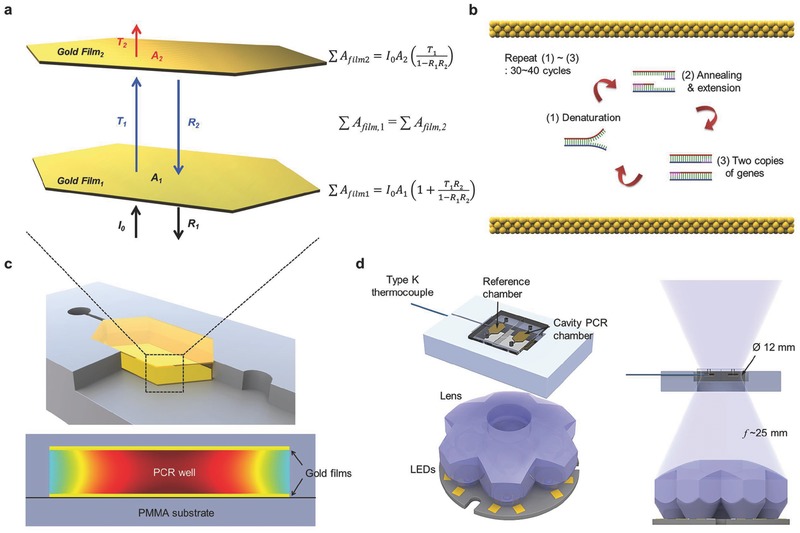Figure 1.

Optical Cavity PCR. a) Schematic of light absorption in the optical cavity for nucleic acid amplification through a polymerase chain reaction (PCR). When a light is illuminated with initial intensity I 0, light is then reflected (R 1), absorbed (A 1), and transmitted (T 1) at gold (Au) film1. Subsequently, the transmitted light is also reflected (R 2), absorbed (A 2), and transmitted (T 2) at Au film2. The reflected light at Au film2 exhibits multiple reflections, absorptions, and transmissions in the optical cavity. The total light absorption of each Au film can be calculated based on this model. For the uniform temperature distribution of the PCR mixture in the optical cavity, the total light absorption at Au film1 should be equal to the total light absorption at Au film2 . A 1 (and A 2), T 1 (and T 2), and R 1 (and R 2): absorbance, transmittance, and reflectance of the Au film1 (and film2), respectively. b) The absorbed light contributes to the photothermal heating of Au atoms for the thermal cycling of the PCR. Thermal cycling, consisting of two or three discrete temperatures for denaturation, annealing, and extension, can be achieved by turning on and off the LED for nucleic acid amplification through the PCR. c) Schematic of cross‐sectional image of cavity PCR chamber and temperature distribution in the PCR chamber. d) Schematic of the LED‐driven optical cavity PCR. (The photograph of the experimental setup is shown in Figure S2, Supporting Information.) A reference chamber with a type‐K thermocouple is placed next to the cavity PCR chamber. The reference and cavity PCR chambers are designed to be covered by the beam waist (ø 12 mm) at the focal length to ensure that both chambers are heated at the same rate. The chambers are placed at the focal length of the lens (25 mm) for efficient light absorption.
